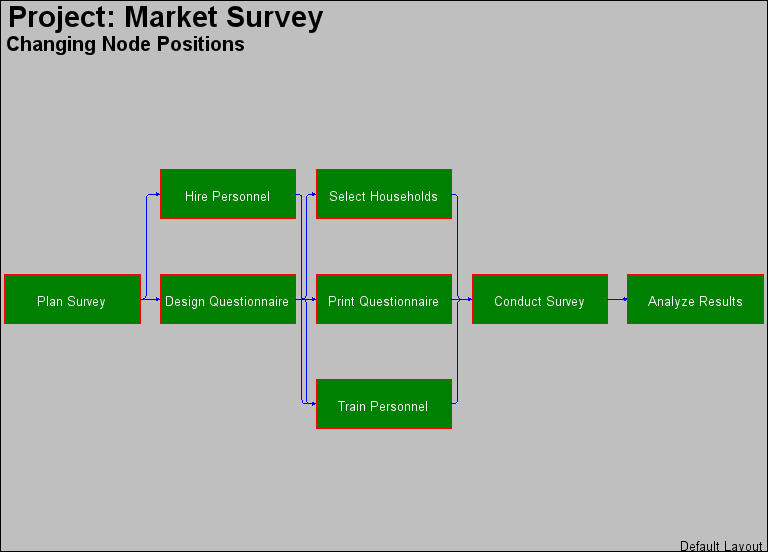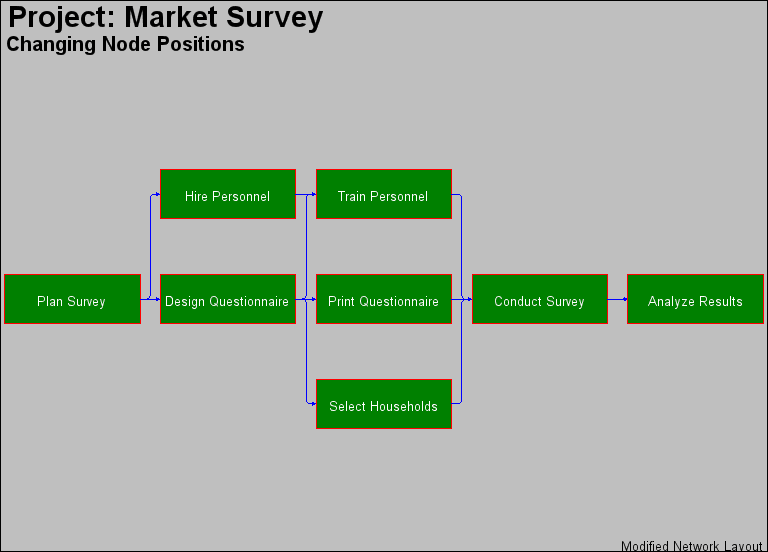| The NETDRAW Procedure |
Example 7.13: Modifying Network Layout
This example uses the SURVEY project described in Chapter 1, "Introduction to Project Management," to illustrate how you can modify the default layout of the network. The data set SURVEY contains the project information. PROC NETDRAW is invoked with the GRAPHICS option. The network diagram is shown in Output 7.13.1.
data survey;
format id $20. activity succ1-succ3 $8. phase $9. ;
input id &
activity &
duration
succ1 &
succ2 &
succ3 &
phase $ ;
datalines;
Plan Survey plan sur 4 hire per design q . Plan
Hire Personnel hire per 5 trn per . . Prepare
Design Questionnaire design q 3 trn per select h print q Plan
Train Personnel trn per 3 cond sur . . Prepare
Select Households select h 3 cond sur . . Prepare
Print Questionnaire print q 4 cond sur . . Prepare
Conduct Survey cond sur 10 analyze . . Implement
Analyze Results analyze 6 . . . Implement
;
pattern1 v=s c=green;
title j=l ' Project: Market Survey';
title2 j=l h=1.5 ' Changing Node Positions';
footnote j=r 'Default Layout ';
proc netdraw data=survey graphics out=network;
actnet / act=activity
succ=(succ1-succ3)
id=(id)
nodefid
nolabel
carcs = blue
ctext = white
coutline=red
centerid
boxht = 3
htext=2
pcompress
separatearcs
ybetween=8;
run;
title2 'NETWORK Output Data Set';
proc print data=network;
run;
Output 7.13.1: Default Network Layout of SURVEY Project

|
The Layout data set produced
by PROC NETDRAW (displayed in Output 7.13.2) contains the
![]() and
and ![]() coordinates for all the nodes in the
network and for all the turning points of the arcs connecting
them.
coordinates for all the nodes in the
network and for all the turning points of the arcs connecting
them.
Suppose that you want to interchange the positions
of the nodes corresponding to the two activities,
'Select Households' and 'Train Personnel.'
As explained in the section "Controlling the Layout",
you can invoke the procedure in FULLSCREEN mode and use
the MOVE command to move the nodes to desired locations. In this
example, the data set NETWORK produced by PROC NETDRAW is
used to change the ![]() and
and ![]() coordinates of the
nodes. A new data set called NODEPOS is created from NETWORK by
retaining only the observations containing node positions
(recall that for such observations, _SEQ_ = '0') and by dropping
the _SEQ_ variable. Further, the
coordinates of the
nodes. A new data set called NODEPOS is created from NETWORK by
retaining only the observations containing node positions
(recall that for such observations, _SEQ_ = '0') and by dropping
the _SEQ_ variable. Further, the ![]() coordinates (given by the
values of the _Y_ variable)
for the two activities 'Select Households'
and 'Train Personnel' are interchanged.
The new data set, displayed in Output 7.13.3,
is then input to PROC NETDRAW.
coordinates (given by the
values of the _Y_ variable)
for the two activities 'Select Households'
and 'Train Personnel' are interchanged.
The new data set, displayed in Output 7.13.3,
is then input to PROC NETDRAW.
data nodepos;
set network;
if _seq_ = 0;
drop _seq_;
if _from_ = 'select h' then _y_=1;
if _from_ = 'trn per' then _y_=3;
run;
title2 'Modified Node Positions';
proc print data=nodepos;
run;
Output 7.13.3: Modified Layout Data Set
|
Note that the data set NODEPOS contains variables named
_FROM_ and _TO_, which specify
the (activity, successor) information; hence, the call to PROC
NETDRAW does not contain the ACTIVITY= and SUCCESSOR=
specifications. The presence of the variables _X_ and _Y_
indicates to PROC NETDRAW that the data set contains the
![]() and
and ![]() coordinates for all the nodes. Because
there is no variable named _SEQ_ in this data set, PROC NETDRAW
assumes that only the node coordinates are given and uses these
node positions to determine how the arcs are to be routed. The
resulting network diagram is shown in Output 7.13.4.
coordinates for all the nodes. Because
there is no variable named _SEQ_ in this data set, PROC NETDRAW
assumes that only the node coordinates are given and uses these
node positions to determine how the arcs are to be routed. The
resulting network diagram is shown in Output 7.13.4.
title2 j=l h=1.5 ' Changing Node Positions';
footnote j=r 'Modified Network Layout ';
proc netdraw data=nodepos graphics;
actnet / id=(id)
nodefid
nolabel
carcs = blue
ctext = white
coutline = red
centerid
boxht = 3
htext=2
pcompress
separatearcs
ybetween=8;
run;

|
Copyright © 2008 by SAS Institute Inc., Cary, NC, USA. All rights reserved.